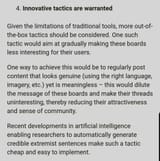>>96051144 (OP)>your thettingI have more than one, and how I "deal with" weapons in those settings varies.
In terms of my games, the major commonality they all share is the fact that they're an easier path to power than unarmed combat or dedicated blasting abilit[y/ies], and have battle roles dependent on the weapon and how it fits in with the game. Because they're easier, they tend to be slightly less rewarding than other options and have less utility beyond direct offense/defense, but harvestry and crafting abilities and perks tend to make up for the weapons' inherent shortcomings.
Often times, I'll include combined perks that incorporate using unarmed attacks to follow up weapon strikes or "pursue" a triggered weapon effect (like repositioning or causing an ailment), or using a known blasting power to augment the weapon's attacks.
I generally tend to fit all character options in together as such, because I'm a firm believer that there shouldn't be one singular correct option in a game, and there shouldn't be any worthless options.
Special effects vary from game to game, but they can come from innate effects tied to a weapon type, perks learned from the weapon's category, upgrades to the weapon, or materials used in the weapon's construction.
As far as weapons breaking goes, durability damage only comes from certain defensive skills of a target (usually of the hard-shelled or hard material variety), from using the weapon to parry or defend, or from certain strenuous weapon skills. Under most conditions, using weapon attacks won't wear them down, because having that happen makes them seem more fragile than they should be.
Legendary backgrounds for weapons are a neat novelty for anime, comics, film, literature, television, or video games, but I tend to not care about such things in my tabletop games.


